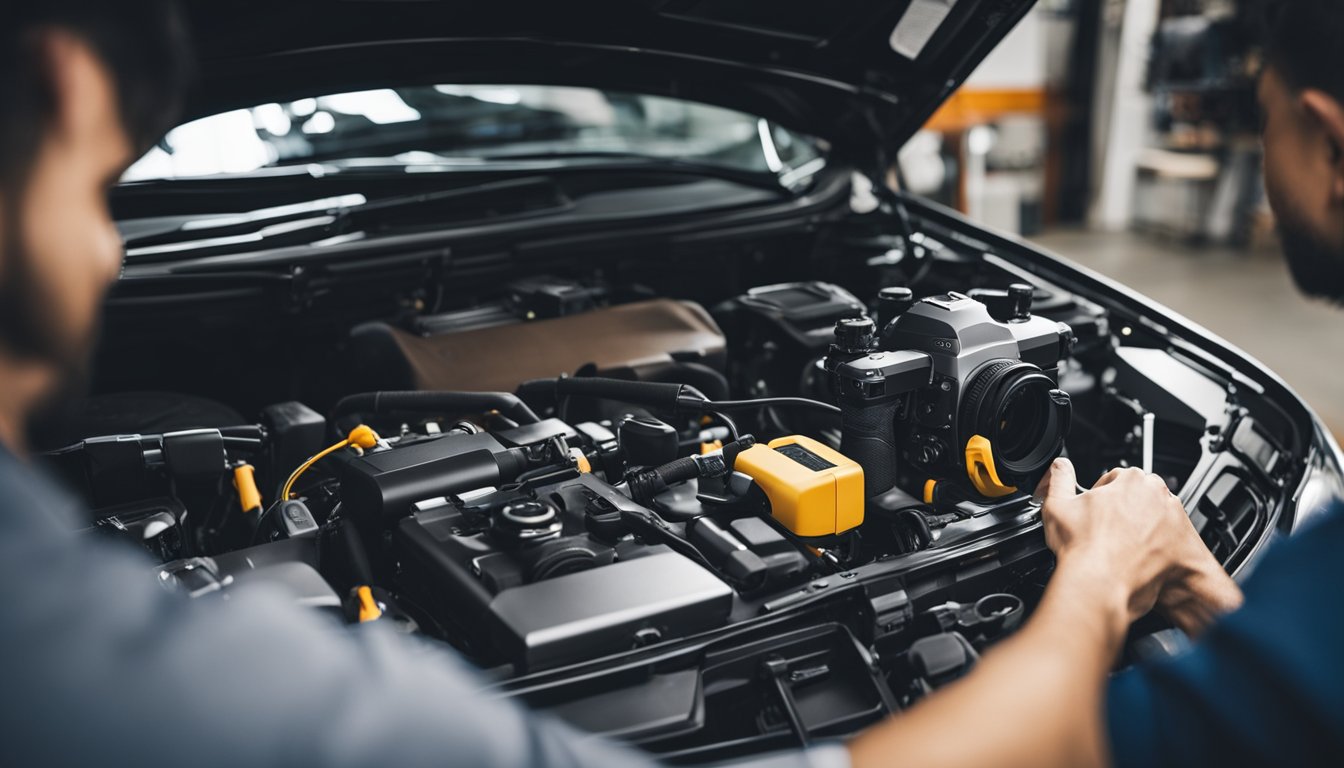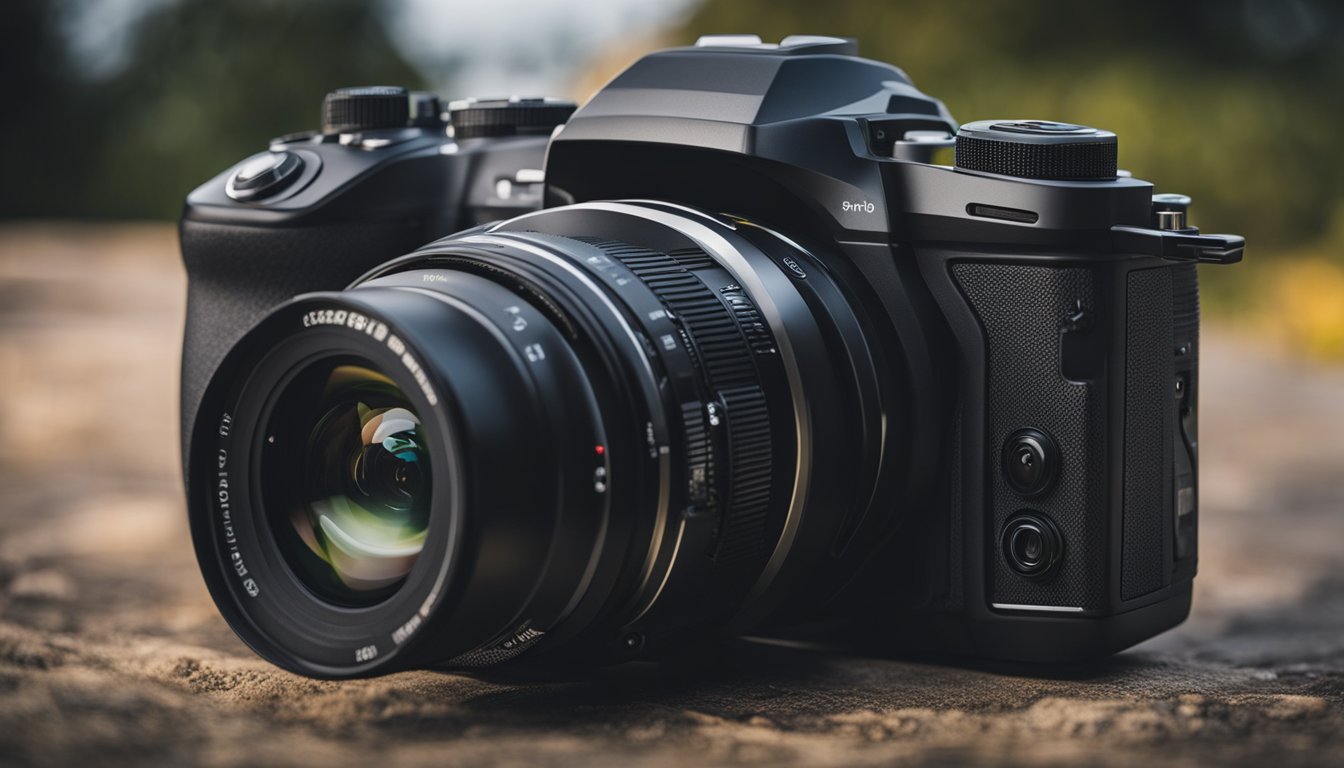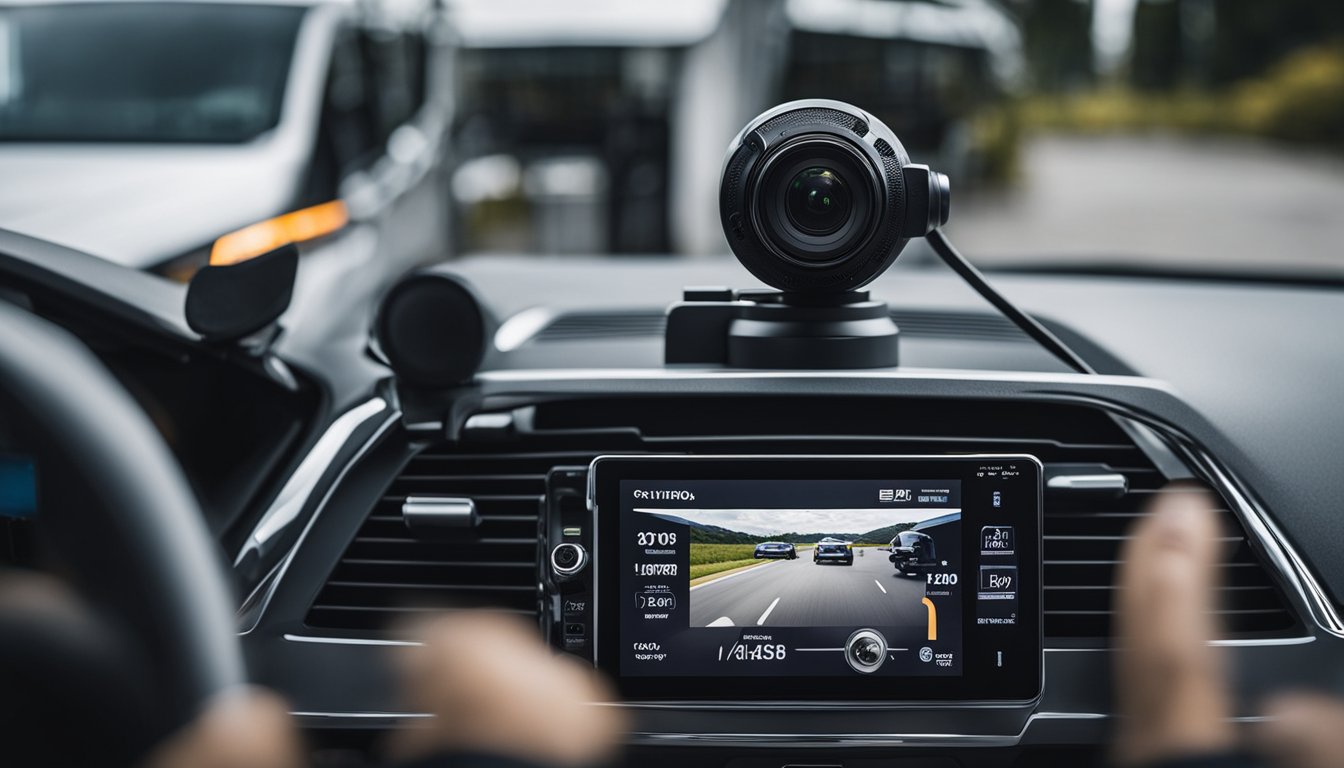If you’re looking to enhance your driving experience and increase safety, adding a 360 camera to your vehicle may be a great option. While many newer vehicles come equipped with this technology, older models may not. The good news is that it is possible to add a 360 camera aftermarket to your car, truck, or SUV.

Before diving into the installation process, it’s important to understand aftermarket 360 camera systems and how they work. These systems use multiple cameras to provide a 360-degree view of your vehicle’s surroundings. The images from each camera are stitched together to create a seamless view, allowing you to see everything around your car. This technology can be incredibly helpful when parking, maneuvering in tight spaces, or navigating unfamiliar areas.
While adding a 360 camera aftermarket is possible, it’s important to note that not all vehicles are compatible with these systems. Some newer vehicles may require additional hardware or software updates to work properly, while older models may not be able to support the technology at all. It’s important to do your research and ensure that your vehicle is compatible before purchasing and installing an aftermarket 360 camera system.
Key Takeaways
- Aftermarket 360 camera systems can enhance your driving experience and increase safety.
- These systems use multiple cameras to provide a 360-degree view of your vehicle’s surroundings.
- Not all vehicles are compatible with aftermarket 360 camera systems, so it’s important to do your research before purchasing and installing one.
Understanding Aftermarket 360 Camera Systems
https://www.youtube.com/watch?v=2XAVQ9qiJ9Q&embed=true
If your vehicle didn’t come with a 360-degree camera system, you might be wondering if you can add one after the fact. The good news is that you can! Aftermarket 360 camera systems are available that will give you a bird’s-eye view of your surroundings, making it easier to park, maneuver, and navigate on the road.
Components of a 360-Degree Camera System
A 360-degree camera system typically includes four cameras, one on each side of the vehicle, that provide a complete view of the car’s surroundings. The cameras are connected to a control module that processes the video feed and stitches it together to create a seamless 360-degree view. The video feed is then displayed on the car’s infotainment system or a separate monitor.
In addition to the cameras and control module, aftermarket 360 camera systems may also include wiring harnesses, mounting brackets, and other installation hardware. Some systems require professional installation, while others can be installed by the vehicle owner.
Benefits of Adding a 360 Camera
Adding a 360-degree camera system to your vehicle can provide a number of benefits, including:
-
Improved safety: A 360-degree camera system can help you avoid collisions by providing a complete view of your surroundings. This is especially useful when parking or maneuvering in tight spaces.
-
Enhanced convenience: A 360-degree camera system can make it easier to park your vehicle by providing a top-down view of the parking space. It can also help you navigate through tight spaces and narrow streets.
-
Increased resale value: Adding a 360-degree camera system to your vehicle can increase its resale value, as it is a desirable feature that many buyers look for.
Overall, an aftermarket 360-degree camera system is a great investment for any vehicle owner who wants to improve their safety and convenience on the road. With the right system and installation, you can enjoy the benefits of a 360-degree camera system without having to buy a new vehicle.
Vehicle Compatibility with Aftermarket Cameras
Adding a 360-degree camera to your vehicle can be a great way to improve visibility and safety while driving. However, not all vehicles are compatible with aftermarket cameras, and it’s important to identify which models are before making a purchase.
Identifying Compatible Models
When it comes to compatibility, some car manufacturers are more open to aftermarket modifications than others. For example, Ford is known for being relatively friendly to aftermarket upgrades, while Audi and BMW tend to be more restrictive.
« Can You Use Xbox 360 Camera on PC? A Quick Guide
Do Teslas Have 360 Camera? Exploring Tesla’s Camera Features »
Before purchasing an aftermarket camera, it’s important to research whether your vehicle is compatible with the system you’re considering. Some cameras may require certain modifications or additional hardware to work properly, and you’ll want to make sure that you’re able to install the camera without damaging your vehicle or voiding your warranty.
Integration with Existing Systems
In addition to compatibility with your vehicle, you’ll also want to consider how an aftermarket camera will integrate with your existing systems. Some cameras may require additional software or hardware to work properly with your vehicle’s display screen or audio system, and you’ll want to make sure that you’re able to integrate the camera seamlessly without causing any issues.
If you’re unsure about how an aftermarket camera will integrate with your vehicle, it may be helpful to consult with a professional installer or your vehicle’s manufacturer. They can provide guidance on which cameras are compatible with your vehicle and how to install them properly.
Overall, adding a 360-degree camera to your vehicle can be a great way to improve visibility and safety while driving. However, it’s important to do your research and make sure that you’re choosing a camera that is compatible with your vehicle and can be integrated seamlessly with your existing systems.
Installation Process Overview
https://www.youtube.com/watch?v=MQzWKsb8UXA&embed=true
If you’re considering adding a 360 camera to your vehicle, you have two options for installation: professional installation or DIY installation.
Professional vs DIY Installation
Professional installation is the recommended option if you’re not comfortable with wiring or don’t have the required tools and equipment. A professional installer will have the expertise to ensure that the camera is installed correctly and that the wiring is properly routed. Additionally, professional installation usually comes with a warranty, so if something goes wrong, you have support to fix the issue. However, professional installation can be expensive and may take several hours to complete.
If you’re comfortable with wiring and have the required tools and equipment, you can install the 360 camera yourself. This option is more affordable and can be completed in a few hours. However, DIY installation can be challenging, and if you don’t have experience with wiring, you may damage your vehicle or the camera. Additionally, DIY installation doesn’t come with a warranty, so if something goes wrong, you’ll have to troubleshoot and fix the issue yourself.
Required Tools and Equipment
Whether you choose professional or DIY installation, you’ll need some tools and equipment to install the 360 camera. Here’s a list of the required tools and equipment:
- 360 camera kit
- Wiring harness
- Screwdriver set
- Drill and drill bits
- Electrical tape
- Wire cutters
- Wire strippers
- Zip ties
- Socket set
Before purchasing a 360 camera kit, make sure it’s compatible with your vehicle. Some kits may require additional wiring or modifications to your vehicle, so be sure to read the manufacturer’s instructions carefully.
In summary, adding a 360 camera to your vehicle can be a great investment for safety and convenience. Whether you choose professional or DIY installation, make sure you have the required tools and equipment and follow the manufacturer’s instructions carefully. If you’re not comfortable with wiring or don’t have the required tools and equipment, professional installation is the recommended option.
Choosing the Right Aftermarket 360 Camera Kit
https://www.youtube.com/watch?v=5MvtlBYOFHg&embed=true
If your car doesn’t come with a built-in 360-degree camera system, you can still add one to your vehicle with an aftermarket kit. Here are some key features to look for when choosing the right kit for you:
Key Features to Look For
-
High-Resolution Cameras: Make sure the cameras in the kit are high-resolution to ensure clear and crisp images. Look for cameras with at least 1080p resolution to ensure you get a clear view of your surroundings.
-
Seamless Integration: Choose a kit that integrates seamlessly with your car’s infotainment system. This will ensure that you can easily access and control the camera system from your car’s display.
-
Compatibility: Make sure the kit you choose is compatible with your car’s make and model. Some kits may only work with specific car models, so it’s important to do your research before making a purchase.
-
Number of Cameras: Consider the number of cameras in the kit. Some kits come with four cameras, while others may have more or less. The number of cameras you need will depend on the size and shape of your car.
Comparing Top Aftermarket Brands
When it comes to choosing an aftermarket 360 camera kit, there are several top brands to consider. Here are some of the most popular options:
-
360fly: 360fly offers a range of high-quality 360-degree camera systems that are compatible with a variety of car models. Their cameras are known for their high-resolution images and seamless integration with car infotainment systems.
-
Rydeen: Rydeen is another popular brand that offers a range of aftermarket 360 camera kits. Their cameras are known for their ease of use and compatibility with a wide range of car models.
-
Brandmotion: Brandmotion is a leading provider of aftermarket camera systems for cars. Their cameras are known for their high-quality images and seamless integration with car infotainment systems.
Overall, choosing the right aftermarket 360 camera kit for your car will depend on your specific needs and preferences. Consider the key features outlined above, as well as the reputation of the brand you choose, to ensure you get the best possible system for your car.
Enhancing Parking and Maneuvering
https://www.youtube.com/watch?v=dKQTy7a4hbw&embed=true
Adding a 360-degree camera to your car can greatly enhance your parking and maneuvering experience. The camera provides a bird’s eye view of your car, allowing you to see all around it. This is especially helpful when parking in tight spots or maneuvering in crowded areas.
Integration with Parking Sensors
If your car already has parking sensors, you can integrate them with the 360-degree camera system to get an even better parking experience. The camera provides a visual representation of the distance between your car and any obstacles, while the sensors provide an audible warning when you get too close. This combination of audio and visual cues can help you park your car with greater precision and confidence.
Reducing Blind Spots
Blind spots are a common problem for many drivers, especially when parking or maneuvering in tight spaces. The 360-degree camera can help reduce blind spots by providing a complete view of your surroundings. This can be especially helpful when backing up or changing lanes.
Overall, adding a 360-degree camera to your car can greatly enhance your parking and maneuvering experience. By integrating it with your parking sensors and using it to reduce blind spots, you can park your car with greater precision and confidence.
Camera Calibration and Maintenance
https://www.youtube.com/watch?v=g4H8msSQhr0&embed=true
Calibrating for Accurate Visuals
Aftermarket 360 camera systems require proper calibration to ensure accurate visuals. Calibration ensures that the cameras are aligned and the images they capture are properly stitched together. Improper calibration can result in distorted or misaligned images, which can lead to visibility issues and safety concerns.
Calibration should be done by a professional installer or a dealership. During calibration, the installer will adjust the camera angles to ensure that they are pointing in the correct direction and capturing the right area. They will also adjust the image stitching to ensure that the images are properly aligned.
Once calibration is complete, it is important to test the system to ensure that it is working properly. This includes checking the image quality and making sure that the cameras are capturing the correct areas.
Routine Checks and Cleaning
To maintain the accuracy and reliability of your aftermarket 360 camera system, routine checks and cleaning are necessary. This includes checking the cameras for any damage or misalignment and cleaning the lenses to ensure clear visuals.
Regular cleaning of the cameras is important to maintain image quality. Dust, dirt, and grime can accumulate on the lenses, which can lead to distorted or blurry images. To clean the lenses, use a microfiber cloth and a cleaning solution specifically designed for camera lenses.
In addition to cleaning the cameras, it is important to check the system for any damage or misalignment. Any damage or misalignment can affect the accuracy of the system and compromise visibility and safety.
By properly calibrating and maintaining your aftermarket 360 camera system, you can ensure accurate visuals and improve visibility and safety while driving.
Software and Firmware Updates
https://www.youtube.com/watch?v=B6X6bwQTTMg&embed=true
If you’re considering adding a 360 camera to your vehicle, you should be aware that software and firmware updates are a critical part of keeping your system up-to-date.
Understanding OTA Updates
OTA, or “over-the-air,” updates are a convenient way to keep your camera’s software up-to-date. These updates are typically delivered wirelessly, either through your vehicle’s built-in Wi-Fi or via a smartphone app. OTA updates can provide new features, improve performance, and fix bugs.
Keeping Your System Up-to-Date
To keep your camera system up-to-date, it’s important to regularly check for software and firmware updates. Check the manufacturer’s website or app for the latest updates, and follow the instructions carefully to ensure a successful update.
It’s also important to note that not all cameras can receive OTA updates. Some may require a physical connection to a computer for updates. Be sure to check the manufacturer’s instructions for your specific camera to ensure you’re keeping it up-to-date.
In addition, be aware that some aftermarket camera systems may not have the same level of support as factory-installed cameras. This means that software and firmware updates may not be as frequent or as reliable. Be sure to research the manufacturer’s support policies before purchasing an aftermarket camera system.
Overall, keeping your camera system up-to-date with the latest software and firmware updates is an important part of getting the most out of your 360 camera. With regular updates, you can ensure that your camera performs at its best and provides the features and functionality you need.
Legal and Warranty Considerations
If you’re considering adding a 360 camera to your vehicle, it’s important to be aware of the legal and warranty considerations. Here are two key things to keep in mind:
Compliance with Local Laws
Before installing an aftermarket 360 camera, you should research local laws to ensure that it is legal to do so. In some areas, adding certain types of cameras or modifying a vehicle’s exterior may be illegal. For example, in some states in the US, it is illegal to mount any object or device on the windshield that obstructs the driver’s view. Therefore, it’s important to check with your local authorities to ensure that the installation of a 360 camera is allowed.
Impact on Vehicle Warranty
Another important factor to consider before adding an aftermarket 360 camera is the potential impact on your vehicle’s warranty. In general, modifying your vehicle with aftermarket parts or accessories can void your warranty, depending on the type of modification and the terms of your warranty. Therefore, it’s important to check with your vehicle manufacturer to understand the impact of the installation on your warranty.
It’s worth noting that some manufacturers offer their own 360 camera systems as optional extras, which can be installed at the factory or by a dealership. These systems are typically designed to work seamlessly with the vehicle and may not impact the warranty. However, they can be expensive and may not be available for all models.
In summary, adding an aftermarket 360 camera to your vehicle can be a great way to enhance your driving experience, but it’s important to consider the legal and warranty implications before doing so. By doing your research and consulting with your vehicle manufacturer, you can ensure that you make an informed decision that meets your needs and complies with local laws.
Troubleshooting Common Issues
https://www.youtube.com/watch?v=RO3a6EGlQcA&embed=true
If you encounter any issues after installing an aftermarket 360 camera, don’t fret. Here are some common problems and solutions to help you troubleshoot:
Addressing Installation Errors
One of the most common issues is installation errors. If you notice that the camera is not working properly, the first thing to check is the installation. Make sure that the camera is properly installed and all the connections are secure. If you are unsure about the installation process, refer to the manufacturer’s instructions or contact a professional installer.
Another common issue is compatibility. Make sure that the camera is compatible with your vehicle. Some cameras may require additional hardware or modifications to work properly. Check with the manufacturer or a professional installer to ensure that the camera is compatible with your vehicle.
Resolving Software Glitches
If you notice that the camera is not working as expected, it could be due to software glitches. In this case, you may need to reset the camera or update the software. Refer to the manufacturer’s instructions on how to reset or update the camera software. If you are still experiencing issues, you can contact the manufacturer’s support team for assistance.
It’s also a good idea to check online forums for any troubleshooting tips or solutions. Many other users may have experienced similar issues and may have found a solution. You can also contact us for support if you are having trouble with your aftermarket 360 camera.
In conclusion, if you encounter any issues with your aftermarket 360 camera, don’t panic. Follow the troubleshooting tips above, and you should be able to resolve most issues. If you are still having trouble, contact the manufacturer’s support team or a professional installer for assistance.
Enhancing the In-Car Experience
https://www.youtube.com/watch?v=yoV4JaYsySs&embed=true
Adding a 360-degree camera to your car can greatly enhance your driving experience by increasing visibility and safety. However, it’s not the only upgrade that can make your ride more enjoyable. In this section, we’ll explore some other ways to enhance your in-car experience.
Connecting to Infotainment Systems
Most modern cars come equipped with an infotainment screen, which allows you to control various features of your car, including the audio system, navigation, and climate control. If your car doesn’t have an infotainment screen, you can easily add one as an aftermarket upgrade.
Connecting your phone to your car’s infotainment system allows you to access your music library, make hands-free calls, and use navigation apps such as Google Maps or Waze. Many infotainment systems also support Apple CarPlay or Android Auto, which provide a more seamless integration with your smartphone.
Improving Audio and Visual Feedback
In addition to adding a 360-degree camera, upgrading your audio system can greatly improve your in-car experience. Aftermarket speakers, subwoofers, and amplifiers can provide better sound quality and a more immersive listening experience.
You can also upgrade the visual feedback in your car by adding a heads-up display (HUD), which projects important information such as speed and navigation directions onto your windshield. This allows you to keep your eyes on the road while still having access to important information.
Overall, upgrading your car’s audio and visual systems and connecting to an infotainment screen can greatly enhance your in-car experience. It’s important to choose upgrades that fit your needs and budget, and to have them installed by a professional to ensure proper functionality.
Additional Resources and Support
If you’re looking to add a 360-degree camera to your car, there are a variety of resources and support available to help you with the process. Here are some of the most helpful resources and support options:
Online Forums and Communities
Online forums and communities are a great place to get advice and support from other car enthusiasts who have already added a 360-degree camera to their vehicle. Some popular online forums and communities include F150Gen14 and Ford Truck Enthusiasts Forums. These forums are full of helpful tips, tricks, and advice on how to add a 360-degree camera to your car.
Professional Help and Services
If you’re not comfortable installing a 360-degree camera yourself, there are plenty of professional help and services available. You can contact your local car dealership or auto repair shop to see if they offer installation services. Additionally, there are many online services that specialize in car camera installation, such as Crutchfield and Best Buy.
No matter which option you choose, it’s important to do your research and choose a reputable service provider. Make sure to read reviews and ask for references before hiring any professional help or service.
In conclusion, adding a 360-degree camera to your car is a great way to enhance your driving experience and improve your safety on the road. With the help of online forums, professional services, and other resources and support, you can easily install a 360-degree camera and enjoy all the benefits it has to offer.
Frequently Asked Questions
https://www.youtube.com/watch?v=k4N8x_H06MY&embed=true
How do I install a 360-degree camera system in my car?
Installing a 360-degree camera system in your car can be a complex process that requires professional installation. The installation process may vary depending on the make and model of your vehicle and the type of camera system you choose. It is recommended that you consult with a professional installer to ensure that the installation is done correctly.
What are the best aftermarket 360-degree cameras available for vehicles?
There are several aftermarket 360-degree cameras available for vehicles. Some of the most popular options include the Garmin BC 30 Wireless Backup Camera, the Auto-Vox X1 Pro, and the Pyle PLCM7500 Car Backup Camera. It is important to do your research and read reviews to determine which camera system is best suited for your needs.
Can I integrate a 360-degree camera system into my existing car’s infotainment system?
In some cases, it is possible to integrate a 360-degree camera system into your existing car’s infotainment system. However, this may require additional hardware or software and may not be possible with all vehicle models. It is recommended that you consult with a professional installer to determine if integration is possible for your specific vehicle.
Is it possible to add side-view cameras to enhance my car’s existing camera system?
Yes, it is possible to add side-view cameras to enhance your car’s existing camera system. This can provide additional visibility and help to eliminate blind spots. However, this may require additional hardware or software and may not be possible with all vehicle models. It is recommended that you consult with a professional installer to determine if adding side-view cameras is possible for your specific vehicle.
What is the typical cost range for installing an aftermarket 360 camera on a vehicle?
The cost of installing an aftermarket 360-degree camera system on a vehicle can vary depending on several factors, including the make and model of your vehicle, the type of camera system you choose, and the complexity of the installation. On average, the cost can range from $200 to $800 or more. It is recommended that you obtain quotes from multiple professional installers to determine the cost for your specific vehicle.
What are the benefits of having a 360-degree camera system in my car?
Having a 360-degree camera system in your car can provide several benefits, including increased visibility, improved safety, and enhanced convenience. With a 360-degree camera system, you can see a complete view of your surroundings, which can help you avoid accidents and make parking easier. Additionally, some camera systems can provide alerts for potential hazards, such as pedestrians or other vehicles. Overall, a 360-degree camera system can help you drive with more confidence and peace of mind.


















